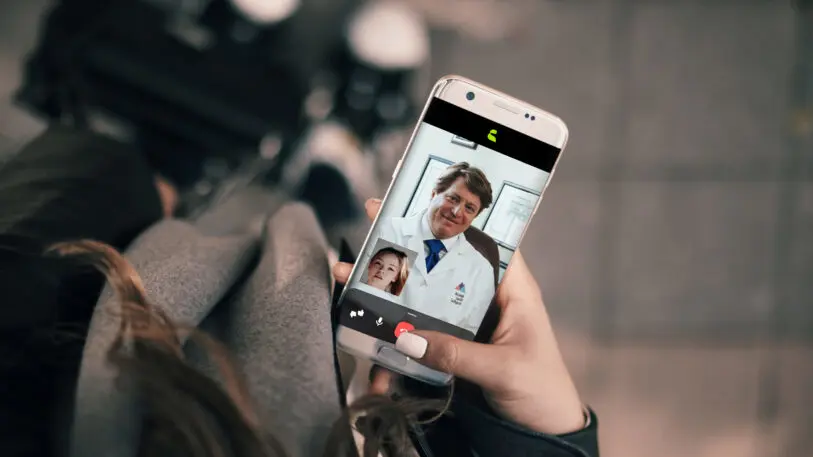Josh has been an opioid addict for over a decade. The 39-year-old Floridian, who was happy to discuss his sobriety efforts on the condition that we chat online, got sober seven years ago using medication and, by 2019, managed to taper off of his medication. But after a difficult divorce and amid the ongoing stresses of the pandemic, he started fearing relapse and began looking for a doctor who could treat him and prescribe medication virtually. There were few options, but he eventually found telehealth opioid recovery service Bicycle Health. Despite initial concerns about about how the online process would go—how do appointments, drug screens, and mandatory counseling work online?—he managed to reach out, be seen, and get a prescription for suboxone all on the same day.
The difficulty Josh had before finding Bicycle Health—and the stigma associated with opioid use disorder—are the exact reasons that the startup exists. Founder Ankit Gupta (no relation) started Bicycle Health in 2017 with the aim of increasing the options for opioid treatment. Gupta is an unlikely founder for a telemedicine company. He got his master’s degree in computer science and started Pulse, a media aggregator that LinkedIn acquired in 2013. However, Gupta’s wife was an internal medicine physician, and many of her patients were dealing with opioid addiction. Gupta became interested in their stories as well as the difficulties of getting treatment. “It’s really hard to get treatment because of how broken our system is,” he says. “Relapse rates are high and stigma is high. Some patients aren’t even comfortable sharing with their spouse.”

Data bears this out. According to a 2017 study, 78% of Americans believe people with opioid addiction are to be blamed for the problem, and 72% of Americans believe people with opioid addiction lack self-discipline. This stigma shapes the treatment options for opioid addiction causing people to focus on behavioral treatments rather than medication. Studies have found that medications such as buprenorphine and naltrexone (Bicycle prescribes suboxone, which is a combination of buprenorphine and naloxone) all reduce opioid use, while behavioral therapy and counseling alone is relatively ineffective. In 2019, less than 18% of people with opioid use disorder received medication for treatment.
To make matters more complex, providers who can prescribe medication for opioid use disorder can be hard to come by. Before December, when the Biden administration changed provider requirements to better address the opioid crisis, doctors prescribing opioid use disorder treatments had to receive specialized training and were limited to treating 30 patients their first year, and ultimately capped at treating 275 patients at a time. (By comparison, a general practitioner might treat 2,0000 patients in a year.) Critics said that process slowed down the treatment course and made it harder to treat opioid addiction than prescribe opioids. The new rules offer companies like Bicycle more room to operate and more responsibility.
When Bicycle began, Gupta acquired a small brick-and-mortar clinic in 2017 as a pilot and started building out telemedicine features. When the pandemic hit, Bicycle was well-poised to switch to a virtual model. Operating virtually, Gupta says Bicycle was able to enroll more patients faster and respond more quickly to their needs. Gupta decided to offer Bicycle’s services virtually across California. “The demand was tremendous and that’s when I realized we could scale this up as a venture-backed company,” Gupta says.
Today, Bicycle treats patients in 32 states and has served 20,000 patients. It is acquiring about 1,000 patients a month and retains 80% of patients over 90 days on average, compared with the industry average of 44% at 90 days. Bicycle accepts insurance and costs $200 a month for the uninsured.

Gupta credits the use of technology with Bicycle’s high retention rate. Bicycle makes it a point to allow patients to book an appointment the same day they express interest, as Josh did. “Our initial time was four days but we found the window of motivation is pretty short. You have to help people get treatment when they want it or they might relapse,” Gupta said. Once patients meet with a doctor, Bicycle’s team works to make sure they can pick up their medication at a nearby pharmacy. To do this, Bicycle built a pharmacy finder which with about 30,000 data points. “It used to take us seven calls per patient, now it’s one,” Gupta says. “We block pharmacies if they stigmatize patients.”
Once patients are on medication, they also have the option to meet with a recovery coach or a support group, which are available five to six times a day. Bicycle also uses random home drug tests to ensure patient accountability, and sends patients a kit and instructions on how to do the drug test. Gupta believes that a virtual model makes it easier to conduct random drug screens because patients are prompted to do the screen within a day, as opposed to coming into a clinic. If a physician suspects sample tampering, Bicycle asks patients to do a saliva swab on camera. In the event of an emergency, the company has providers on call 24/7, or patients can call their local ER. How long a patient stays on medication depends on a combination of factors, including how long they’ve been using opioids. Short-term users are usually able to taper off of medication, but long-term users may have to use medication for the rest of their life.
Though tech has made it easier to get patients treatment faster, the telehealth industry broadly has come under fire by watchdog organizations for sending sensitive patient information to Big Tech companies. According to a tracker by the Opioid Policy Institute, Bicycle was among the companies that used ad trackers that send data for anyone who visits their website to Google, Adobe, Amazon, and Microsoft. An investigation by The Markup and STAT found that Bicycle notified Google and Bing that an email address had been entered in the enrollment confirmation URL.
Gupta points out it is difficult to reach Bicycle’s target client since there’s so much stigma around opioid addiction, and it relies on ad trackers—which the company stopped using while this story was being reported—to determine who Bicycle’s target audience is and how to advertise to them. He says this has hindered the company’s ability to reach the right customer, but declined to provide numbers.
Gupta also notes that while patient data isn’t shared once someone is being treated, internally Bicycle uses this data to understand which patients respond better to which types of treatment and help their providers make better treatment decisions. “A big part of our program’s success has been the effort we’ve put into reaching patients directly rather than relying on referrals,” says Bicycle’s chief medical officer Brian Clear. “You can’t rely on the rest of the health system to identify these patients.”
As a patient, Josh has no problem with Bicycle Health using trackers. “I don’t mind if Bicycle Health tracks who goes to their website as long as they aren’t selling that data to a third party that could potentially take advantage of people in active addiction,” he said. “Everyone tracks everything nowadays, so it doesn’t really bother me.”
Kyle Zebley, the senior vice president of public policy at the American Telemedicine Association, points out there’s a perception that telemedicine is unregulated. “Fraud and abuse are actually more likely to be sussed out given the digital trail,” he says. Still, given that often regulations are written after an industry slips up and telehealth is still nascent, I asked Gupta what he thinks about balancing patient need against Bicycle’s growth and making the difficult decisions about how to operate. “We have to rely on morality and ethics,” he says. “The challenge any company faces with digital marketing is how to balance privacy and growth. When guidelines change, it’s easy to look back and say something was the wrong decision.”
Today, Josh is still with Bicycle and recommends it unhesitatingly, except he does wish it could be cheaper even though his insurance pays for it. “I do get paranoid that the conservatives in power will attempt to remove virtual medication-assisted treatment now that the pandemic is winding down, as thousands of people rely on it,” he wrote, “but I just take it one day at a time and hope for the best!”
Recognize your brand’s excellence by applying to this year’s Brands That Matter Awards before the early-rate deadline, May 3.
